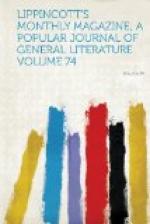Again, he writes to Dr. Sheridan: “No soul has broken his neck or is hanged or married; only Cancerina is dead.[6] I let her go to her grave without a coffin and without fees.”
St. Patrick’s, which was, in a deplorable state during Swift’s deanship, and indeed for a century after, is now restored to its original magnificence. Indeed, it may be doubted whether it is not in a condition superior to what it ever was. This superb work has been effected entirely by the princely munificence of the Guinness family, the great stout brewers of Dublin; and Mr. Roe, a wealthy distiller, is now engaged in the work of restoring Christ Church, the other Protestant cathedral.
I paid a visit to the Bank of Ireland, the edifice on which the hopes of so many patriotic Irishmen have been centred, insomuch as it is the old Parliament-house. The elderly official who conducted us over the building took us first through the bank-note manufacturing rooms, where we espied in a corner a queer wooden figure draped in a queerer uniform. Demanding its history, he said that the clothes had belonged to an old servant of the establishment, and were discovered after his decease a few years ago. Formerly the Bank of Ireland was guarded by a special corps of its own, and the ancient retainer, who had been a member of this very commercial regiment, was proud of it, and had kept his dress as a cherished memorial. When George IV. came to Ireland, on his celebrated popularity-hunt, in 1821—previous to which no English monarch had visited Ireland since William III.—he graciously condescended to give the bank a military guard, which has since been continued. On the day I went I found a number of soldiers of the Scots Fusileer Guards occupying the guard-room. The officer on duty receives an allowance of two dollars and a half for his dinner. At the Bank of England he gets instead a dinner for himself and a friend, and a couple of bottles of wine.
The interior of the Parliament-house is almost the same as when Ireland had her own separate legislature. The House of Lords is in precisely the condition in which it was left in 1801. It is a large oak-paneled, oblong chamber of no particular beauty, and might very well pass for the dining-hall of a London guild. There is a handsome fireplace, and the walls are in great part covered with two fine pieces of tapestry representing the battle of the Boyne and the siege of Derry, King William, “of glorious, pious and immortal,” etc., being of course the most conspicuous object in the foreground. The attendant stated that a special clause in the lease of the buildings, to the Bank of Ireland Company stipulated that the House of Lords was to remain in statu quo. Perhaps it may return some of these days to its former use. The House of Commons, a large stone hall of stately dimensions, is now the cash-office of the bank. There seemed nothing about it architecturally to call for special notice. I mooted the probability




